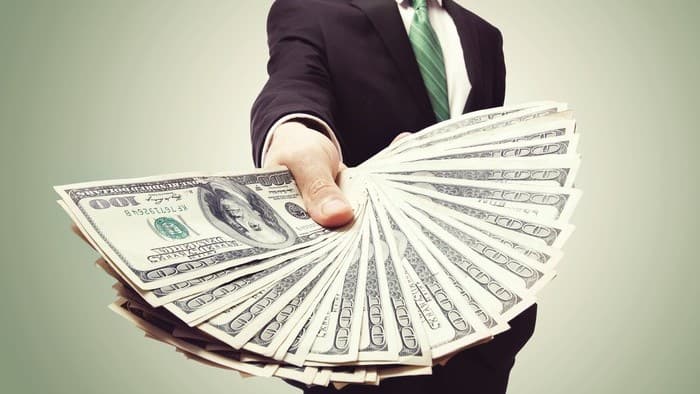With Australia's interest rates effectively zero – or even negative – ASX dividend shares are in the spotlight for 2021.
We'll get to 2 ASX income shares you may want to investigate further for your own portfolio shortly.
But first, let's look at why the real returns you're likely to get on your cash savings are actually negative.
On 3 November, the Reserve Bank of Australia (RBA) took the unprecedented step of cutting the official cash rate to a rock bottom 0.10%.
Governor Philip Lowe indicated the bank has no intention to reduce rates into the negative range. But the RBA's $100 billion quantitative easing (QE) program is intended to keep a tight cap on borrowing costs. And hence on what you'll receive in your role as lender from your term deposit account.
As it stands, you'll be hard-pressed to get more than 0.5% in interest on a 1-year term deposit. Or $500 per year on a $100,000 deposit.
If that doesn't sound like much, that's because it isn't.
Unfortunately, that figure is your nominal return. Meaning it doesn't take inflation into account.
Even if inflation is only 1% in 2021 (well below the RBA's target of 2–3%), your real (inflation adjusted) return from that term deposit would be –0.5%. In other words, by the end of 2021 the purchasing power of the by then $100,500 in your term deposit will be around $500 less than it was on the first of the year.
And if you've been holding your breath waiting for cash savings rates to go higher, you can let that breath out.
The odds of that happening are slim to none.
Low rates to the horizon
Australia may be isolated geographically. But when it comes to the RBA's cash rate, the bank's decisions are intricately entangled with the world's other leading central banks.
And none appear to have any intention to raise interest rates in the foreseeable future.
On Wednesday, the US Federal Reserve, the world's most watched central bank, doubled down on its own QE policies to keep borrowing rates low and money flowing through the system.
Fed Chair Jerome Powell said the bank will continue its US$120 billion (AU$159 billion) of monthly bond purchases until inflation and employment demonstrate "substantial further progress".
The European Central Bank (ECB), the Bank of Japan (BoJ) and most every other major central bank across the world is firmly on the same low interest rate track.
Not only is this likely to remain the case throughout 2021, but the RBA has previously stated it's likely to keep the cash rate at historic lows for as long as 3 years.
And on 1 December Lowe said:
In Australia, the economic recovery is underway, and recent data has generally been better than expected. This is good news, but the recovery is still expected to be uneven and drawn out, and it remains dependent on significant policy support.
This ongoing "significant policy support" won't be music to the ears of Australian savers. But it's certainly good news for borrowers. The bigger your debts, the better that news.
And no one in Australia is more indebted than our own federal government. Yet another reason to expect lower interest rates for longer.
From the Australian Financial Review:
The federal government estimates it will save an extra $457 million in interest payments over the next four financial years following the Reserve Bank's massive government bond buying program that has been driving borrowing costs down…
In this financial year the government will save $56 million in interest payments on its $852 billion in debt compared to what it was projecting just two months ago.
The outlook for ASX dividend shares
Before moving on to ASX income paying shares, a reminder on some widely held general financial advice.
Cash in the bank is undoubtedly safer than money invested in shares. Particularly if your bank is covered by the Federal Government's Deposit Guarantee. This covers up to $250,000 per authorised deposit-taking institution should the bank run into solvency issues.
You should also keep enough cash on hand to cover several months of living expenses should your other income sources dry up, plus enough to meet any emergency spending issues.
With that said, the outlook for ASX dividend shares in general for 2021 is looking up.
According to Shane Oliver, Head of Investment Strategy & Economics and Chief Economist at AMP Capital, 2021 is likely to see ASX companies returning more money to their shareholders via dividends.
Speaking at AMP's webinar earlier this month, Oliver noted:
As we go through 2021, I reckon the dividends will start to go back up again… We're looking at dividend payments on the Aussie market over the next 4 months of somewhere between 4–4.5% [up from the recent 2.9%]… Our indicators for Australia are now looking healthier than they are in Europe and the US.
2 ASX dividend shares for 2021's zero to negative rate world
There are a number of quality shares on the ASX paying regular dividends.
Here are 2 that may be worth investigating further.
First up is Australia's largest rail-based transport business, Aurizon Holdings Ltd (ASX: AZJ).
Aurizon's share price still hasn't recovered from the pummeling it took during the initial COVID-driven market selloff, which saw shares fall 35%. Year-to-date Aurizon's share price remains down 22%.
Now I hold no opinion as to where Aurizon's share price is heading in 2021. But if you're after extra income from your ASX shares, Aurizon pays a dividend yield of 6.7%, 70% franked.
The second ASX dividend share you might want to look into further is Rural Funds Group (ASX: RFF). Rural Funds is a real estate investment trust (REIT) that focuses on agricultural assets across Australia.
The Rural Funds' share price also took a steep hit from the February and March market selloff. But shares have rebounded strongly, and Rural Funds' share price is now up 34% year-to-date.
Again, whether or not it continues that strong performance in 2021 is beyond the focus of this article. But if it's real, inflation beating income you're after, Rural Funds pays a dividend yield of 4.3%, unfranked.









